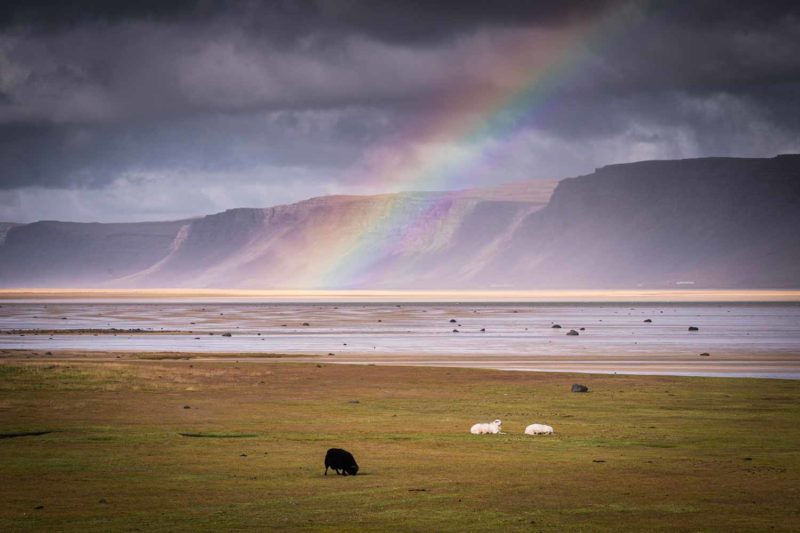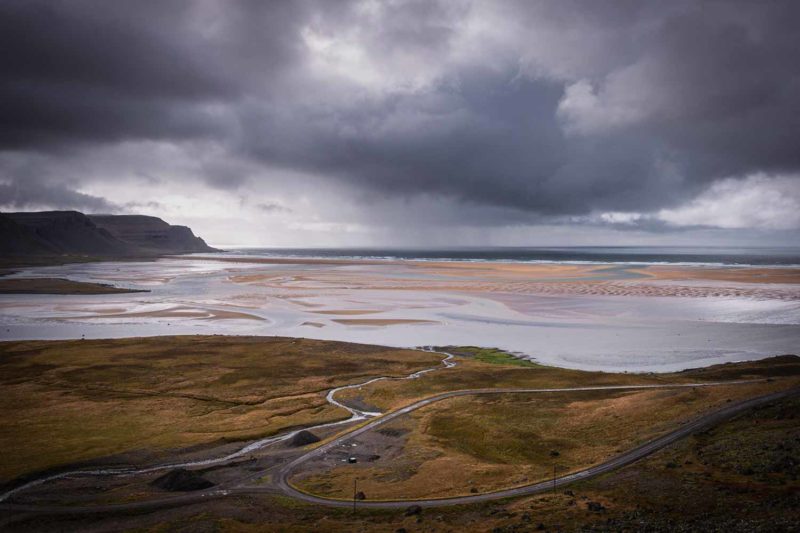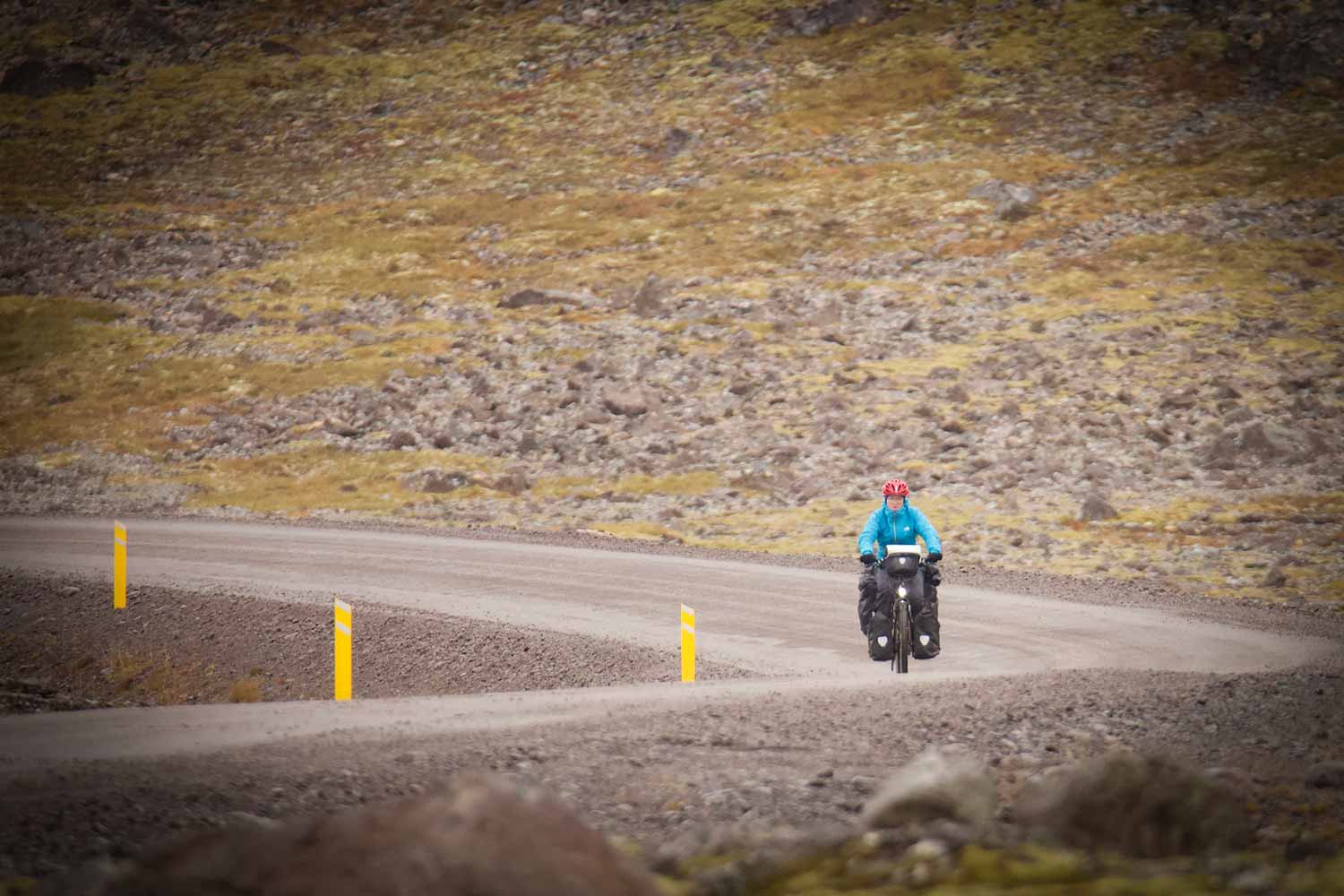In the red box that stands as a refuge at the edge of the water, I listen to the gusts of wind that make the metal cables vibrate and whistle in the interstices. I have been waiting for several hours in this emergency shelter at the end of Hornstrandir, that the storm that began in the night calms down. The wind gently strengthened until it reached impressive gusts. The sound of the wind makes me worried. It has been weeks that I am facing it and I have seen what it is capable of.
The clouds run at full speed and the rain moves slowly away. But I have to wait before starting the trek again. Wait for the wind to calm so that I can walk normally. I think of my cycle through the Highlands, a few weeks ago. My few days of crossing the central desert. The second day was hell on earth with bursts preventing me from pedaling. I remember my despair at the small number of kilometers traveled in three hours. To have felt so small, so insignificant, fluttered by gusts, my face streaked with dust, my mind maddened by the whistling of the wind in my ears.
There have been others days in hell. There were some very difficult ones, especially towards the end of my bike trip on the West Coast. In fact, the vast majority of the trip was a fight of every second against the wind. In Iceland, the wind is permanent. Every day, all the time, the island is beaten by this cold breath, unbeatable, forever changing. There are no days without wind. Or very little. Sometimes the wind drops a little but it never lasts a long time. It seems to go down at night to resume at the first light of the day.
Arriving in Iceland almost two months ago, I knew the weather was going to be difficult. It was going to be cold, rainy and windy. I knew it. But I did not understand it. There are many things that we know without understanding them. I had decided to confront myself to the elements, the difficulty, the inhospitable landscapes. But the reality is different. The breath of the elements is a monster, unbeatable, in front of which I am nothing. It destroys my mind and weakens my strength. It makes everything cold and austere. And then it seems to stubbornly take pleasure in slowing me down on my bike. Always (or almost) from the front, no matter where I go. Here, it is difficult to predict a stable route over several days. The weather changes constantly. The climate is unstable. Good weather, ephemeral. A lull between two storms. My bike trip to Iceland has been entirely shaped by the wind. I had a hard time coping with it, accepting it. To give up my route plan because of this stormy wind. But it quickly became the main element of my thoughts. I have never had my mind so focused on the wind.
In Europe or elsewhere, I do not remember being so aware of the wind. Yet the wind exists in France. Especially in Provence, where my parents live, blows the Mistral. This dry wind, with squalls more than 100km/h, has shaped the architecture of houses and vegetation. Before Iceland, I thought the Mistral was the pinnacle of tough winds. A hungry beast capable of destructive bursts. Blowing a good part of the year. But it has never seemed so much present to me as the Icelandic wind. The Mistral blows but its presence is not as strong. Here, on the island, the wind surrounds, swallows everything from its overwhelming presence. It is an angry god who pushes me down.
The side wind seems to be the worst. Traitor, violent, dangerous. The bursts push the bike on the side and I have to pedal inclined to try to compensate. But the slightest disturbance reinforces the dangerousness of the enterprise. The passage of cars, a slight lull can modify this wall of air against which I hardly support myself and suddenly make it disappear. And I must immediately restore balance. An unexpected gust takes me by surprise and my bike runs in the side or on the other side of the road. The mind is on the alert, invaded by worry, scrutinizing the next flurry. Some places, close to the sea or with too much traffic require to dismount. Driving with a strong side wind makes the trip very dangerous. Having headwind is facing a wall. Impassable. Rolling with headwind is long, difficult and painful. Each pedal stroke requires double or triple effort. And the kilometers stretch painfully. But it remains less dangerous than with a strong side wind. Add to the wind, the rain and you have the perfect nightmare of the cyclist in Iceland.
Stories of travelers facing the wind, I have heard many times. In Dreki, a few kilometers from Askja, bursts sent a big camping tent of the Fire & Ice 2019 marathon into the air. And it returned another tent with six people inside. Another day wind was so strong that pebbles were flying. At the foot of the Kerlingarfjöll mountains my tent has almost be torn in two by the squalls. On the Laugavegur Trail, mini-cyclones filled the floor of my tent with black dust. Here all the shelters are reinforced by metal cables to hold them in place. And in bivouac, pebbles and small stone walls consolidate the mooring of the tents on the ground.


Raudasandur beach.
Iceland is on the path of cyclones. These monsters of power, forming thanks to the meeting of the cold air coming from Canada and the hot air of the Atlantic, go back to the North-East and fall down on Iceland. Only island in the middle of the ocean. Some reliefs obstructing the way. Increasing the strength of the winds and precipitation brought by cyclones. The majority of the rainfall falls on the west and south coasts, the first obstacles to the passage of cyclones. And so the wind blows most often from the west (northwest, west, southwest). Areas without relief experience even stronger winds. Especially in the center and the Highlands, where the majority of the landscape is composed of mineral desert. But the topography of some areas, such as those of large valleys framed by high mountains, creates corridors in which the wind rushes suddenly changing direction. This is particularly noticeable in the Westfjords, where the wind seems to change direction continuously. Glaciers dotting Iceland also play a very important role in the strength of the wind, since the difference in temperature between the cold glacier and the surrounding warmer areas, increases the force of the wind. Many storms of sand and dust appear regularly in summer in the center and especially in the Vatnajökull area, the largest icecap.
These localized glacial winds erode the ground, reinforcing storms of sand or dust. The majority of Icelandic vegetation consists of mosses, small heathers and grasses. A short, fragile vegetation with slow growth. Climate, volcanic activity, glacier movement and overgrazing have made plant growth difficult. But even if the wind plays a major role, the big changes in the Icelandic vegetation are of human origin. Approximately 60% of Iceland was covered with vegetation when the first settlers arrived. Today only 25% remains. In the Highlands, farmers are now trying to fertilize the soil with a resistant grass to stop erosion. And replant trees. To bring some protection against the destructive wind.
I wonder what impact does this permanent wind have on Icelanders? How does it shapes their character? What impact does this slap have on the way of living of Icelanders? How do they live without trees, in the cold the great majority of the year, folded in two under the gusts? Is the wind associated with fear? How do you adapt to this kind of climate? I watch children having fun outside. The strong wind makes the hair of a little girl fly in all directions. Yet that does not seem to bother her. She is having fun. Should one be born here on this island in the middle of the ocean to not worry about the wind? Or is it just the carelessness of the age? Probably the Icelanders have a stronger mind than mine, able to cope with difficult weather conditions. A rougher character, ruste, reinforced, shaped by the elements that surrounds them. By this permanent austerity. By this constantly changing climate. By the vagaries of time. Perhaps that explains their quiet temperament? Would capricious weather shape mind? In order not to have too many expectations, to know how to react calmly and simply and to adapt to changing situations? Would it be this particular climate, with a large part of the year confined in the cold and the dark, that boost the creativity of the people here? As a loophole, do Icelanders create to forget fear and bad weather?
It would seem that this is the case. My bike trip to Iceland was not easy, far from it. And it was not a pleasure either. I often wanted to finish quickly. But this difficult climate confrontation through biking and hiking seems to have had an impact on me. An impact on my character. It forced me to review my expectations, to adapt, to accept unexpected changes, to take what Iceland brought to me every day, with peace. And to create. An infinity of ideas, thoughts fell on me as I pedaled and walked through the desert landscape, through the drops, zigzagging under gusts. The harsh and unstable climate as a forger of a quiet and creative character. Humility and simplicity. A lesson of the elements for a development towards something better.

On my bicycle – photo by Guðlaugur J Albertsson
Sources:
Wikipedia
The wind in Iceland (in French)
Adventures in Iceland (in French)
Islandic Vegetation
